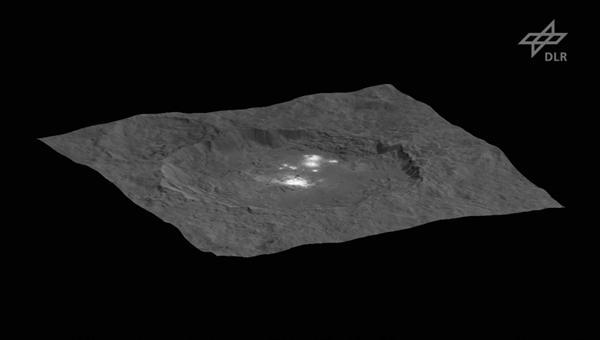Ceres – crater walls steeper than the north face of the Eiger

Your consent to the storage of data ('cookies') is required for the playback of this video on Quickchannel.com. You can view and change your current data storage settings at any time under privacy.
NASA/JPL-Caltech/UCLA/MPS/DLR/IDA

The north face of the Eiger in the Bernese Alps is legendary; mountaineers consider the steep walls of the 1800-metre drop to be a difficult and challenging climb. But 326 million kilometres from Earth, the sheer cliffs of the Eiger find their match on the dwarf planet Ceres, where at some points, the wall of the Occator crater towers precipitously at a height of almost 2000 metres. "The walls of the crater are nearly vertical in some areas, although in others a large amount of material has slipped into its interior," says planetary researcher Ralf Jaumann from the German Aerospace Center (Deutsches Zentrum für Luft- und Raumfahrt; DLR). "Also, these two extremes are located immediately next to one another." New images acquired by the German-developed Framing Camera system on board the Dawn spacecraft clearly capture this structural phenomenon. So far, the scientists have been unable to explain why the edges of Occator crater are stable in some places and unstable in others.
Viewed from above
The walls of the crater appear sharp-edged when viewed from an altitude of 1470 kilometres. Approximately 25 percent of the crater walls are almost vertical. In contrast, large sections of the edges immediately adjacent have slipped down into the inside of the crater. "Perhaps there are differences in the material composition around the rim of the crater – or the strength may vary." In addition, cracks and plains are scattered across the crater interior. The planetary researchers are able to visualise greater detail as the spacecraft tightens its orbit around Ceres, giving them plenty of material to ponder. Measuring almost 1000 kilometres across and possessing a roughly spherical shape, Ceres is a celestial body that almost became a planet when the Solar System formed. But 'almost' is the operative term here – Jupiter's gravitational field prevented Ceres from accumulating the additional material it needed to qualify as a planet. Named one of the five official dwarf planets by the International Astronomical Union (IAU) in 2006, Ceres is the first in this category of celestial bodies to be studied. "The Dawn mission is giving us the opportunity to take a long look at how the Solar System emerged," emphasises Jaumann.
Ceres in three dimensions
Researchers from the DLR Institute of Planetary Research are using the images acquired by the camera system to generate a terrain model of Ceres, which reveals the dwarf planet in the third dimension – elevation. Using material from this terrain model, a video was produced shows viewers the 90-kilometre wide Occator crater. The vertical scale of the video is exaggerated by a factor of 1.5 to accentuate the crater's topography; the highest point is 6000 metres greater than the lowest. At the centre are the mysterious bright patches whose origin and nature remain the subject of scientific debate.
Stereo images for the terrain model
Since 13 August 2015, Dawn has been flying in what has, so far, been its lowest orbit over Ceres. Since then, it has completed its first 11-day tour around the celestial body, transmitting images from an altitude of 1470 kilometres above the surface. In total, the camera system will map the entire surface of Ceres six times, on each occasion looking down onto the dwarf planet from a slightly different angle. The DLR planetary researchers will then use these stereo images to refine their three-dimensional terrain model. There will be a temporary interruption in the acquisition of new image material at the end of October, lasting until Dawn reaches its lowest and final orbit at an altitude of 375 kilometres two months later.
The mission
The Dawn mission to Vesta and Ceres is managed by NASA’s Jet Propulsion Laboratory (JPL) in Pasadena, which is a division of the California Institute of Technology, for NASA's Science Mission Directorate in Washington DC. The University of California, Los Angeles, is responsible for overall Dawn mission science. The camera system on the spacecraft was developed and built under the leadership of the Max Planck Institute for Solar System Research in Katlenburg-Lindau, Germany, with significant contributions from the German Aerospace Center (DLR) Institute of Planetary Research in Berlin and the Institute of Computer and Communication Network Engineering in Braunschweig. The Framing Camera project is funded by the Max Planck Society, DLR, and NASA/JPL.
